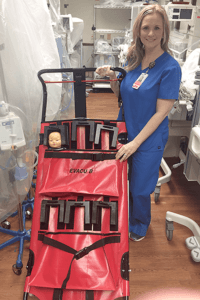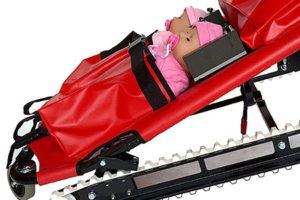
Hospitals around the world are updating – and upgrading – their emergency evacuation plans with an innovative baby evacuation device which enables the safe and speedy rescue of up to six babies at a time. This may sound like hype, but consider this: with game-changing safety features which directly solve the problems with traditional infant evacuation devices, it’s no surprise that emergency planning committees are scrambling to make the switch.

If you manage a nursery, NICU or SBCU as part of a hospital evacuation plan, you’ll want to know about the Evacu B baby evacuation device. Here’s why.
A failsafe emergency evacuation plan is essential for every building, whether it’s residential, commercial or civic. But for buildings with vulnerable occupants, such as people with disability, elderly people and babies, evacuation plans are even more important – and often, more complicated.
This is certainly the case for hospitals, which need purpose-built evacuation equipment to quickly deliver sick and injured people and babies to safety in an emergency situation in accordance with AS 4083-2010 Planning for emergencies – Health care facilities.
The problems with traditional infant evacuation devices
Evacuation chairs are essential for evacuating elderly people and people with limited mobility or disabilities in the event of an emergency, especially in multi-level buildings with stairs. With these chairs, a carer can wheel an incapacitated person to safety via stairs.
For babies, who are the most vulnerable of all, evacuation is more complex, and this leaves a gaping hole in every hospital’s evacuation plan. Using a single-occupant cot or fire-resistant aprons with large pockets, nurses can carry one to three babies to safety at a time. Unlike evacuation chairs, this leaves babies vulnerable to serious risks: should the nurse trip or fall, the babies are at risk of injury or death. The nurse cannot easily set down the babies to clear debris or obstacles, and once outside of the building, there is no safe place to leave the babies for care.
If this sounds like a problem, it’s because it is – and this problem is exactly what led to the development of the Evacu B baby evacuation device.

Unlike traditional baby evacuation devices, the Evacu B has a purpose-built track system that allows it to latch firmly onto stairs to ensure a controlled descent without bouncing. And, with an automatic braking system which can support a fully-loaded Evacu B chair even on stairs, nurses can stop and release their grip on the device to clear debris if required.
Quick and easy to deploy, the Evacu B also features an O2 cylinder cradle where an optional six-way oxygen supply system can be attached and fed through to each pocket in the event of low air quality.
So, with two to three times the carrying capacity of traditional baby evacuation equipment and the inclusion of a braking system that can hold on stairs, the Evacu B is significantly more safe and efficient during an evacuation.
When a device like this is so readily available to improve the safety of babies in hospitals, nurseries and specialist baby care units in a fire or other emergency, making the switch from traditional baby evacuation aprons or cots is more than an option – it’s an obligation.
If you’re interested in upgrading your hospital evacuation plan with the Evacu B baby evacuation device visit evaculife.com.au/product/evacu-b-emergency-baby-evacuation or our full range of other industry-leading emergency and fire safety products, view the range at evaculife.com.au

